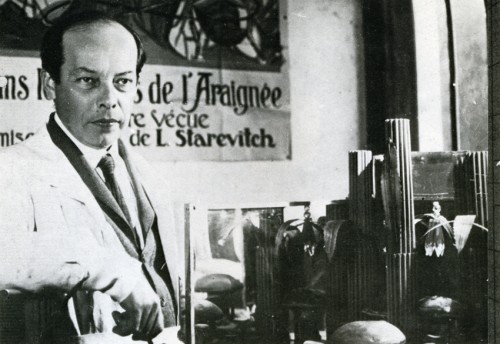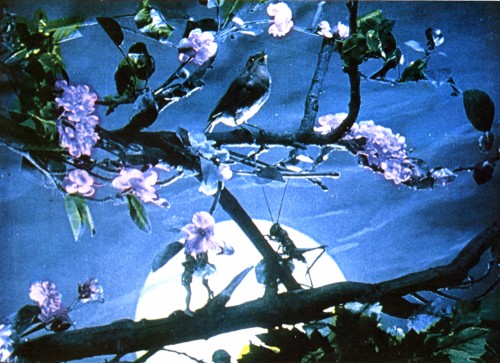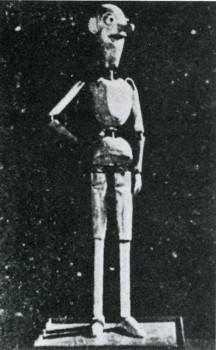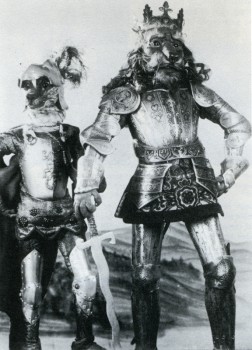Animation Artifacts &Articles on Animation &Puppet Animation 03 Oct 2007 07:31 am
Starévitch
- I’m continuing a small series of lifts from a catalogue I have which features master French animation pioneers. It was a souvenir of a 1981 Parisian exhibition on the history of French animation.
My focus here is one of the greatest stop motion animators in history, Ladislas Starévitch. I’m offering, here, a loose translation of the catalogue entry (with a couple of additions I’ve chosen to add.)

Ladislas Starévitch (1882-1965)
- Born to a Polish family living in Moscow a century ago, Starévitch was an entomologist. When the idea occurred to him to use the technique of frame by frame animation to reconstruct aninsect battle which he’d witnessed, animation entered his life. The film was titled Lucanus Cervus (1910).
So attracted to this conceit of animating his bugs, in the next few years, he made several other stop-motion films before actually beginning a full-time career in animation. This included one of his most famous films, The Revenge of a Kinematograph Cameraman in 1912. The Russian Revolution led to his emigration to France in 1919; this put a temporary halt to his filmmaking. However, a new career began in France when he started to make fiction films exclusively. Assisted by his daughter, Irene, he grew dedicated to 3D puppet filmmaking for the rest of his life.

The Voice of the Nightingale (1923)
Poet and craftsman, as inventive as he was clever, Starévitch created new films including In the Spider’s Grip (1920), The Voice of the Nightingale (1923), and The Eyes of the Dragon (1925), etc. Many technical innovations came from his fertile imagination and resulted in a high level of animation.
Starévitch completed a full-length film (65 mins) entitled The Story of Fox (1930) which found distribution years later (1941) after adding sound to the feature. He lzo created a series with the dog “Fétiche” (1934) as his principal protagonist.
_ __
__
_To the left, an early Starévitch armature from the MOMA collection.
_To the right, a scene from The Story of Fox.
When I was young I had a 16mm print of The Revenge of the Kinematographic Cameraman, and I think I must have watched that print a couple of hundred times. I was absolutely intrigued with the accomplishment he had done in 1912 and felt, then, that it was on the same level as Winsor McCay’s Gertie the Dinosaur.
I’ve seen a number of his films at the Museum of Modern Art and was completely taken with his technique and craft in the film, The Magical Clock (1928) (aka The Little Girl Who Wanted to Be a Princess). The film includes some amazing combinations of Live Action with stop motion animation.
It’d be lovely if some of these films were collected for dvd release in a good quality version. Because many of these films are in public domain, there are a lot of bad, unwatchable copies out there. The official website for Starévitch includes links to some copies of films from Doriane Films including The World of Magic of Starevitch and The Story of Fox. Presumably these might be the best available.

on 03 Oct 2007 at 12:21 pm 1.Ken Priebe said …
One of the most popular Starewitch films to circulate in the film/video market is ‘The Mascot’ from 1933. An excerpt re-titled ‘The Devils Ball’ appears on the Johnny Legend Weird Cartoons compilation. The Em Gee Film Library released a complete print from what I understand. The official DVD compilation of Starewitch’s films features the British cut of the film, which removes all references to alcohol (the shot of the drunk dropping the wine bottle that the devil emerges from, and all the shots of puppets drinking).
Starewitch had a trademark technique of employing wispy motion blurs into his animation. This might have been achieved by smearing vaseline on a glass plate in front of the camera for the blurred frames.
Most of Starewitch’s films are lost, and his granddaughter, L.B. Martin-Starewitch, who lives in France, is still searching for prints of the films we’re not able to see. Typing in ‘Starewitch’ in the search window on YouTube and Google Video will provide many different clips of his work.
on 03 Oct 2007 at 12:37 pm 2.Ray K. said …
Michael, there is an excellent Starewicz DVD compilation with good, clear transfers, called “The Cameraman’s Revenge and Other Fantastic Tales,” on the Image Entertainment label. They’re at 20525 Nordhoff Street, Ste. 200, Chatsworth, CA 91311/ http://www.image-entertainment.com
on 03 Oct 2007 at 2:05 pm 3.Tom Minton said …
There’s an Image Entertainment 1993 laser disc titled “The Cameraman’s Revenge and Other Fantastic Tales” containing seven of Starewicz’s films. I may be the only one who purchased it, having seen a 16mm print of “The Revenge of the Kinematograph Cameraman” in college and remembered it for its sheer creative audacity. “Cameraman” might well be the first animated tale about adultery committed to film, and surely the first using dead insects tricked up with wire armatures to tell the story. In addition to a high level of craft, Starewicz shared the ability to shock with McCay, particularly the McCay of “Dreams of the Rarebit Fiend.”
on 03 Oct 2007 at 7:34 pm 4.Brian Kolm said …
The Story of Fox, I believe, used life size puppets for stop-motion. I would like to see that one. There are nice clips on DarkStrider.com http://www.darkstrider.net/gallery2a.html
Brian
http://www.atomicbearpress.com
on 14 Oct 2010 at 9:43 am 5.Idaho certified pilots said …
One of the most popular Starewitch films to circulate in the film/video market is ‘The Mascot’ from 1933. An excerpt re-titled ‘The Devils Ball’ appears on the Johnny Legend Weird Cartoons compilation. The Em Gee Film Library released a complete print from what I understand. The official DVD compilation of Starewitch’s films features the British cut of the film, which removes all references to alcohol (the shot of the drunk dropping the wine bottle that the devil emerges from, and all the shots of puppets drinking).
Starewitch had a trademark technique of employing wispy motion blurs into his animation. This might have been achieved by smearing vaseline on a glass plate in front of the camera for the blurred frames.
Most of Starewitch’s films are lost, and his granddaughter, L.B. Martin-Starewitch, who lives in France, is still searching for prints of the films we’re not able to see. Typing in ‘Starewitch’ in the search window on YouTube and Google Video will provide many different clips of his work.
on 26 Feb 2014 at 2:13 am 6.Young Cheser said …
Great blog you have here but I was wanting to know if you knew of any community forums that cover the same topics discussed here?
I’d really like to be a part of community where I can get feed-back from other experienced people that share
the same interest. If you have any recommendations, please let me know.
Appreciate it!
on 19 Jan 2015 at 4:32 pm 7.Richelle said …
As a Newbie, I am constantly browsing online for
articles that can aid me. Thank you
on 29 Oct 2022 at 9:22 am 8.Víctor said …
Hi Michael! Are you sure that the MOMA´s armature belongs to Starevich? Thanks.